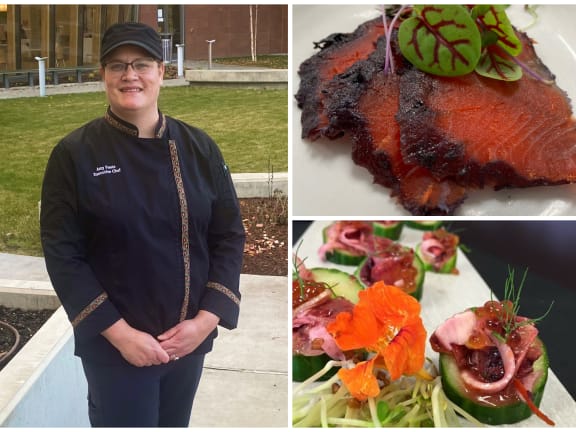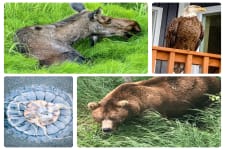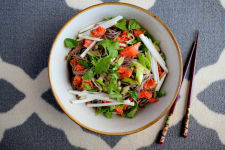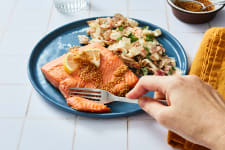While I’m still out on leave (just for a little longer!), and in honor of Women’s History Month, I want to share an inspiring conversation one of my colleagues had with Amy Foote, Senior Area Executive Chef of Alaska Native Tribal Health Consortium (ANTHC) Medical Campus in Anchorage, Alaska. Just for some context, the ANTHC provides comprehensive medical and health services to Alaska Native and American Indian patients through programming that strives to meet their unique needs.
Through her work, Chef Amy uses food as medicine to help patients heal, often tapping into the culinary heritage of her patients to ensure they’re having all of their needs met. Food, after all, is so much more than a dietary requirement. Food can be medicine to the body and soul.
I’ll let my colleague Kristin Gole, WAC Content Strategist, tell you a little more about Chef Amy and the incredible work that she does.
***
When I first (virtually) met with Chef Amy Foote, a photo of her holding something floral and interestingly-patterned appeared on the zoom screen. I told her they reminded me of the cherry blossoms that were starting to bloom outside of my window in New Jersey. She enthusiastically painted an animated description of the herring eggs she was holding in the picture, which had been harvested on a spruce branch, then explained how she used the eggs to feed the patients she serves at the Alaska Native Medical Center in the Tribal Health Consortium Campus. It was clear we were from different worlds, but her excitement drew me in immediately.
Chef Amy and her team serve over 5000 meals a day, but unlike other hospital food programs, she takes into account the healing properties of food — a lesson Alaska continues to teach her over and over. Her work bridges tradition and innovation in search of the larger impact food and food systems have on our lives.
You’re originally from Montana. What brought you to Alaska?
I worked summers in Alaska since I was 15, in Prince William Sound. After spending time back in Montana, I kept asking myself, how do I get back to Alaska? Alaska is really polarizing for people. It either moves in and sets up camp in your heart, or it doesn’t. For me it always called me back.
I totally hear you on that one. What did that call sound like for you?
For me, it’s almost a spiritual connection, magical. There’s this surreal awe that happens living here. We just had the most amazing northern lights. They were so close to my house, it felt like you could touch them. I can come around the corner driving home and see a moose giving birth.
I can pull up in my driveway and have a grizzly bear in my yard. There are magical extremes that play off of each other. We have restricted times and then vast blasts of beauty.
There are things in Alaska you can only experience in Alaska. The ability to be really, truly alone in the wilderness. You can feel that stillness. Having that connectivity for my kids was really important to me. I wanted my kids to be self-sufficient, to be able to learn that everything you need is around you. Alaska is one of the few places that you can still do that. You walk out and you have your food source and your medicine source right there. Both of my boys stack firewood, harvest moose, catch fish. My youngest is a plant nerd in the making.
Tell me a little bit about your understanding of food as healing.
Healing through food comes in many forms. The act of growing and foraging is healing. Interacting with the land, the act of sharing and giving, is an act of healing between each other. The act of eating gives comfort, nourishment and wellness. The act of honoring the ingredients and utilization is healing. Using food for healing is actually a secret and rewarding gift of working here.
Specifically in your line of work, how do you go about using food to heal?
People usually have this stigma for hospital foods, but we get to actually heal people. We had a patient that was here for months. They had lots of long term healing to do after a plane crash. People get tired of eating the same thing, so I went and sat with the patient. We talked about the foods that sounded good, the foods they would consume, even their own family recipes.
One of the big things we bring in when we can is seal [an ingredient respected and long used by native Alaskans], so I made them seal soup. They were amazed! They asked, “Where did you get seal?? How do you know how to cook seal??”
Just watching this patient take this first spoon of seal soup and the relaxation that occurred after that — there goes your stress, there goes your anxiety, after months of being in a hospital. If you can make someone take a deep breath, it’s a huge part of healing. The medicine has its place, but if you are anxious, food can add that comfort, which provides that calmness that can allow you to heal.
There’s also a nutritional aspect. To be able to offer the foods that are tied genetically to our patients that their ancestors ate — like seal, like caribou, like moose — that’s another aspect of healing we get to provide. We serve a lot of salmon. Salmon is tied to all of the regions of Alaska, and we’re feeding people from all over the state.
Well, we love salmon here at WAC too! Tell me about your relationship with salmon.
Salmon is what Alaskans live and die by. It’s how we feed ourselves, how we feed our children, how we feed our sled dogs. We even use it as a textile, like salmon leather!
A lot of fishing happens in Alaska, and one of the things I frequently hear about is the frustration of discarded litter, of carcasses and eggs after a fishing trip. But all of those are nutrient dense and completely edible foods. So last year we started a program and began to collect donations of heads, spines, eggs (what’s called spoon meat). We turned it into fish head soup. There’s a lot of collagen in it. It’s really great healing, and that’s what you want in a hospital.
It’s women’s history month, so I have to ask, what is it like being a female in a male-dominated industry?
After over 30 years, it has been an evolution. In my earlier years, I was frequently the only woman in the kitchen. This required working twice as hard, proving myself each and every moment of each and every day.
Eventually, there was a point where I felt like I’d proven myself enough. I got tired of proving myself to people and I wanted to take those lessons and help others learn and grow and blossom. I went into more of a teaching, mentoring role.
I’m a builder. I’m known for pushing people out of their comfort zones and challenging them to do things they didn’t know they could do; like presenting, teaching, being in front of a crowd, carving at a station. I have folks I’ve hired that were unhoused and on the street. I hired them and mentored them into sous chef roles. I believe in constant learning, giving back, offering opportunities for growth and honoring my own teachers. I also strive to create a culture of family where we all support each other toward our common success.
What lessons have you learned from female mentors or elders?
Elders are the keepers of the past to help guide us to the future. I have learned many powerful lessons from female elders. Most resonant in me is to ethically harvest, take only what you need and can honor by using every bit of. Support your elders who can no longer harvest and learn from those who can. Observe quietly and learn all you can. Do everything with reciprocity, intention, respect and love.
What do you want people in the Lower 48 to know about seafood from Alaska?
People need to look at their box of wild Alaskan fish as a box of gold.
Knowing the survival it took for that fish to grow, the voyage to even get out to sea and survive — I want everyone to have awareness and passion for continuing to protect what allows us to have that beautiful fish, whether that’s looking at the water regulatory practices, the land, to making sure that fish can continue to come back every year. That’s really important to me. I also want people to know that fishing is the livelihood of a very awesome community of people.
And from a chef’s perspective: please don't overcook it! Wild Alaskan salmon is less fatty than a farm raised Atlantic salmon. I sometimes hear, “Oh it’s so dry,” but it’s not if you don’t overcook it! Honor that ingredient!
***
Thank you to Amy for talking with the WAC team!
Before I sign off today, with Ramadan beginning this week, I am reminded of a wonderful New York Times article published last year about how the diverse Muslim community in Anchorage observes this period of fasting. I highly recommend this read — in fact, I just reread it myself.
For those of you who observe Ramadan, I wish you a happy and generous Ramadan. And Happy Women’s Month to all!
Live Wild,
Monica
Pictured above: Chef Amy Foote in her chef jacket, alongside a couple of the culinary creations that she’s developed to help nourish patients at the Alaska Native Tribal Health Consortium Medical Campus.






